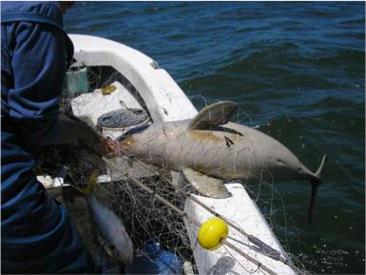
A new review of marine mammal bycatch in gillnet fisheries from 1990 to 2011 has been published in the open access journal, Endangered Species Research, in a theme section on Techniques for reducing bycatch of marine mammals in gillnets.
Efforts to look at marine mammal bycatch on a global scale have been few. The last major attempt of this kind, the 1990 Symposium and Workshop on the Mortality of Cetaceans in Passive Fishing Nets and Traps, convened by the International Whaling Commission, focused on cetacean bycatch only. Similarly, the last description of global pinniped bycatch was published in 1991 (Woodley and Lavigne). This paper sought to update bycatch data for all marine mammals; to determine where data gaps exist; and to identify species and populations that are known or likely to be at serious risk from bycatch in nets.
The authors collected reports of marine mammal bycatch from over 570 sources, including primary and gray literature, government and NGO reports, and personal communications with experts in the field. They found that since 1990, marine mammal bycatch has occurred in the waters of 90 countries and overseas territories and that bycatch included at least 92 different species:
- 56 of 74 (75%) recognized odontocete species
- 9 of 14 (64%) mysticete species
- 21 of 32 (66%) pinniped species
- all sirenian and marine mustelid species
Despite the immense data collection effort, the authors believe that their data under-represents the true number of marine mammals caught incidentally in fisheries each year, as well as the locations where bycatch occurs for a few important reasons. First, what is known about marine mammal bycatch is a reflection of the distribution of research and observational effort - which leaves significant gaps in space and time. Also, understanding the scope of marine mammal bycatch is obscured in areas where there is a fine line between accidental and deliberate catches. In addition, estimating the amount 'cryptic' bycatch, where the animal is entangled in fishing gear and either swims away injured and dies later or dies and falls out of gear before they are observed, is difficult.
This study reinforces how little is known about marine mammal bycatch in much of the world and suggests that bycatch remains a critical issue to be addressed in order to prevent further losses of marine mammal diversity and abundance.
Questions can be directed to: kmcclellan@neaq.org
Citation: Reeves RR, McClellan K, Werner TB (2013) Marine mammal bycatch in gillnet and other entangling net fisheries, 1990 to 2011. Endangered Species Research 20: 71-97 (PDF) (Supplements)
Featured Bycatch Species

Non-target benthic invertebrates are caught as bycatch in huge volumes, but precise numbers are not available.
